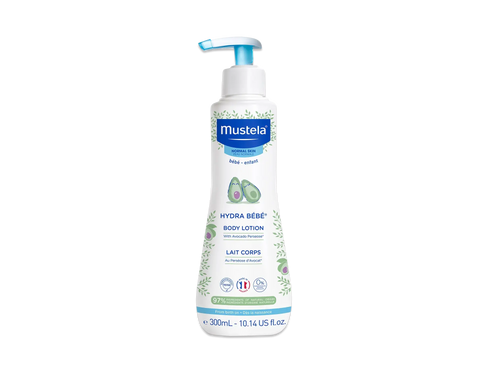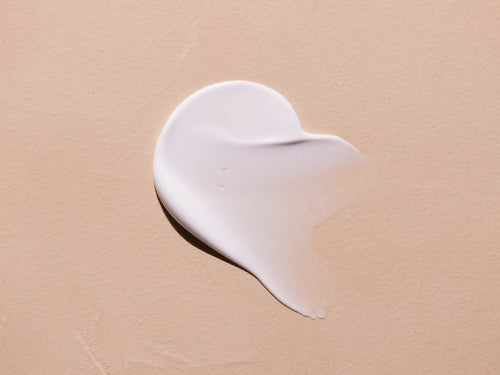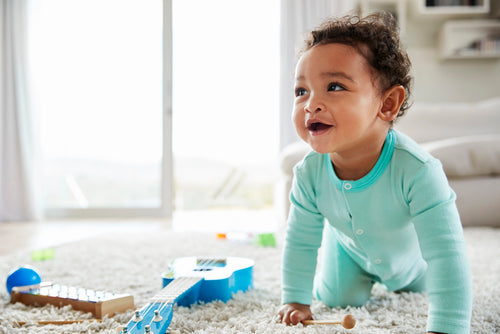If you’ve been wondering how to get your baby to sleep in their crib, this article is just for you.
We know how frustrating it can be! You’ve put so much time and effort into creating the perfect nursery for your little one — the bedding, colors, and cute mobile were all carefully selected. Everyone loves it, except for your baby.
The most confusing part is that your baby sleeps everywhere else (in your arms, the car seat, the stroller, etc.) with no problem. So why is sleeping in the crib such a challenge?
The experts at Mustela share why your little one may not be crazy about their crib and, most importantly, what you can do to change this.
Why Your Baby Won’t Sleep In Their Crib
Before we focus on how to get baby to sleep in crib, we need to talk about why they aren’t sleeping in it in the first place.
There are many reasons babies may struggle to sleep in their own beds. Here are some of the most common.
1) Sleeping Somewhere Else

Your little one probably already has a few sleeping spots they love. In fact, one of the most common places your baby may happily fall asleep is in your arms or on your partner’s chest.
Why is that? Falling asleep in mommy's or daddy’s arms is easy because babies understand the world around them through their senses.
For example, your little one finds comfort from the warmth of your arms and the way you smell, which makes it easy for them to doze off because they associate your scent with love and safety.
2) Separation Anxiety
Does your little one become anxious, fussy, or even cry uncontrollably whenever you leave the room? If so, they may be experiencing separation anxiety.
Separation anxiety commonly starts at around eight months and reaches its peak between 14 and 18 months. At this stage, babies simply don't understand that even when they can’t see you, you may still be in the room (object permanence).
During this stage, when babies see their parents or primary caregivers leave the room, they think they are gone for good!
The good news is this doesn't last forever. Children gradually outgrow separation anxiety during early childhood, but it is another reason why sleeping alone in their nursery can be challenging for a little one.
3) Growth Spurts

We can’t discuss how to get your baby to sleep in their crib without talking about growth spurts.
Babies usually experience their first growth spurts between one and three weeks old and again between six and eight weeks. You can also expect to see growth spurts around three, six, and nine months.
While these growth spurts usually only last a couple of days or so, your child may have an increase in appetite, wake up more often, and be fussier than usual.
If you’re trying to get your little one to sleep in their crib during these transitions, it can feel like an impossible mission.
4) Illness

While being sick as an adult is hard, being sick as a baby can be even harder. In fact, it may be more frustrating for your little one because they don’t yet know how to communicate their discomfort (except through crying, of course).
Teething, ear infections, and colds are common culprits, as babies often experience all kinds of soreness and discomfort with each. In addition, these illnesses often interrupt their sleeping patterns.
Besides illness, common skin conditions, like baby acne, diaper rash, and eczema, often leave babies feeling uncomfortable, further contributing to sleep disruptions.
To soothe and restore your little one’s skin, here are some helpful options from Mustela:
- Organic Micellar Water With Olive Oil And Aloe, which gently cleanses the face, hands, body, and diaper area.
- Diaper Rash Cream 123, which relieves and recovers your baby’s delicate skin after every diaper change.
- Diaper Cream with Olive Oil and Aloe, which is EWG (Environmental Working Group) Verified and safe for even the most sensitive skin.
- Stelatopia Cleansing Oil, which is an oil-based cleanser specifically formulated for extremely dry and eczema-prone skin.
- Stelatopia Skin Soothing Pajamas, which use microcapsule technology, to deliver skin-soothing moisture to eczema-prone skin throughout the night.
From environmental factors to growth spurts, there are many reasons your little one may not be fond of their crib just yet. How can you help your baby through these challenges?
How To Get Baby To Sleep In Crib

1) Remember That Timing Is Everything
No matter how well-prepared you are, if your little one is sick or going through a growth spurt, expecting them to sleep in their crib just may not happen.
Understanding this is important because, during these periods, their sleeping patterns will change, and having to make the trips back and forth between your room and theirs can drain your energy.
Don’t add more stress to your plate by trying to force the issue. Instead, introduce your little one to their crib under good circumstances. You don’t want them to associate their crib with pain or discomfort. Plus, it will be easier on you!
2) Use A Swaddle Or Sleep Sack

Using a baby swaddle is an excellent answer to the question of how to get baby to sleep in crib because they give your little one the warmth and comfort they crave.
You can feed them, swaddle them, and then gently place them into their crib as they drift off to sleep.
Keep in mind, however, that if your little one has started rolling over (usually around four months), it’s best to transition them to a sleep sack as it’s no longer safe to swaddle them.
3) Spend Time In The Nursery
Your little one may not be too crazy about their crib right now because they are unfamiliar with it. If they’ve been sleeping in a bassinet or a bedside co-sleeper, this is all they know and are comfortable with.
One of the best ways to familiarize them with their crib is to spend more time in the nursery.
This might involve playing in the room during the day, reading, or feeding them in the space. You can also start laying them in the crib for their daytime naps to help ease the transition.
4) Check The Room Temperature
Another reason your baby may not be a great crib-sleeper is because of room temperature. Ideally, you want to ensure that the temperature in your baby’s room is between 68 and 72 degrees Fahrenheit.
This keeps the room not too cold or too warm and allows your little one to drift off to sleep peacefully. Additionally, studies have also shown that overheating is a SIDS risk.
The bottom line? Babies aren’t able to regulate their body temperature at a young age, so it’s essential to always set their room temperature to a safe, comfy range.
5) Put Them Down Sleepy But Awake

It can be tempting to allow your little one to doze off in your arms because you love the warm and cozy feeling as much as they do.
While snuggling is important, if your baby always dozes off in your arms, they’ll struggle to learn how to fall asleep independently. Instead, try putting them down while they are drowsy and starting to fall asleep but are still awake.
This may involve rocking your baby until they are sleepy and then placing them gently in the crib so they can start learning how to drift off to sleep on their own.
6) Keep Their Bedtime Routine The Same
It’s challenging for babies to handle many changes at the same time (and if we’re honest, it’s not that easy for adults either!). This is why keeping your little one’s bedtime routine the same is important, no matter where they sleep at night.
We recommend giving your little one a massage before bedtime to help them relax and get ready to snooze. Our Melting Massage Balm is ideal, as it is designed to moisturize and nourish your baby’s skin, leaving it supple and soft.
Whether you choose feed-bath-massage, feed-bath-storytime, or any other combination, doing the same activities in the same order alerts your little one that their bedtime is fast approaching.
By having a consistent routine, they will slowly start associating their nursery and crib with bedtime.
Be Patient And Consistent

Learning how to get your baby to sleep in their crib can be challenging. While the process may involve many tears (from the baby and from you!), remember that, eventually, everything will work out.
No matter where you are in the sleep process, there are a few things you can do to help your little one: Make the transition at the right time, use a swaddle or sleep sack for comfort, and spend time in their nursery to help familiarize them with their new sleep environment.
Additionally, it’s important to check that the temperature in their room is just right, to put them down while they are sleepy, and to try to keep their bedtime routine consistent.
Remember that babies sometimes struggle to fall asleep because of skin irritations. Try Mustela’s Stelatopia Cleansing Oil, Diaper Rash Cream 123, Organic Micellar Water With Olive Oil And Aloe, or Melting Massage Balm to help soothe and comfort your little one.
While it might be challenging to familiarize your baby with sleeping in their crib at first, with a few helpful tricks and lots of consistency, your baby will find comfort in their crib and start dozing off on their own before you can say, “bedtime!”










